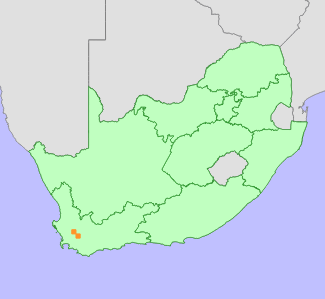|
Scientific Name | Ixia mostertii M.P.de Vos |
Higher Classification | Monocotyledons |
Family | IRIDACEAE |
National Status |
Status and Criteria | Endangered B1ab(iii,v)+2ab(iii,v); C1+2a(i) |
Assessment Date | 2015/06/08 |
Assessor(s) | P. Goldblatt, I. Ebrahim, D. Raimondo & L. von Staden |
Justification | Only three known subpopulations of this localized endemic to the Breede River Valley (EOO 82 km²) remains, with the population numbering fewer than 1000 mature individuals, and the largest subpopulation consisting of less than 250 mature individuals. The population has already declined by at least 20% within two generations (20 years) and continues due to ongoing habitat loss and degradation. |
Distribution |
Endemism | South African endemic |
Provincial distribution | Western Cape |
Range | Wolseley to Worcester. |
Habitat and Ecology |
Major system | Terrestrial |
Major habitats | Robertson Karoo, Breede Shale Fynbos, Breede Alluvium Fynbos |
Description | Shale flats and slopes. |
Threats |
| This species has lost habitat to agricultural expansion in the Breede River Valley near Wolseley, and to urban expansion around Worcester. Recently, part of a small, isolated subpopulation was lost to expanding fruit orchards. Part of a subpopulation on the outskirts of Worcester was lost to a housing development in the past 20 years, and the remainder of this subpopulation occurs on a site earmarked for development, where ongoing construction of infrastructure is already causing ongoing habitat loss and degradation. A third subpopulation has been impacted by the development of a casino and golf course, and informal settlements are spreading across the remainder of this site. |
Population |
Three known remaining subpopulations of Ixia mostertii continue to decline due to ongoing habitat loss and degradation, with an estimated 20% population reduction within the past 20 years. The largest subpopulation numbers fewer than 250 mature individuals, with about 100 plants recorded at the second, and the smallest subpopulation consisting of fewer than 50 mature individuals. Intact habitat remaining at a fourth site where this species was last recorded in 1962 still needs to be surveyed. The population is estimated to number fewer than 1000 mature individuals.
|
Population trend | Decreasing |
Assessment History |
Taxon assessed |
Status and Criteria |
Citation/Red List version | | Ixia mostertii M.P.de Vos | EN A2c; B1ab(ii,iii,iv,v)+2ab(ii,iii,iv,v); C1 | Raimondo et al. (2009) | | Ixia mostertii M.P.de Vos | Rare | Hilton-Taylor (1996) | |
Bibliography |
De Vos, M.P. 1999. Ixia. In: O.A. Leistner (ed). Flora of Southern Africa 7 Iridaceae Part 2: Ixioideae, Fascicle 1: Ixieae:3-87. National Botanical Institute, Pretoria.
Goldblatt, P. and Manning, J.C. 2000. Cape Plants: A conspectus of the Cape Flora of South Africa. Strelitzia 9. National Botanical Institute, Cape Town.
Goldblatt, P. and Manning, J.C. 2016. Systematics of the southern African genus Ixia L. (Iridaceae): 5. Synopsis of section Ixia, including five new species. South African Journal of Botany 104:175-198.
Hilton-Taylor, C. 1996. Red data list of southern African plants. Strelitzia 4. South African National Botanical Institute, Pretoria.
Raimondo, D., von Staden, L., Foden, W., Victor, J.E., Helme, N.A., Turner, R.C., Kamundi, D.A. and Manyama, P.A. 2009. Red List of South African Plants. Strelitzia 25. South African National Biodiversity Institute, Pretoria.
|
Citation |
| Goldblatt, P., Ebrahim, I., Raimondo, D. & von Staden, L. 2015. Ixia mostertii M.P.de Vos. National Assessment: Red List of South African Plants version 2024.1. Accessed on 2025/11/19 |
 Comment on this assessment
Comment on this assessment


